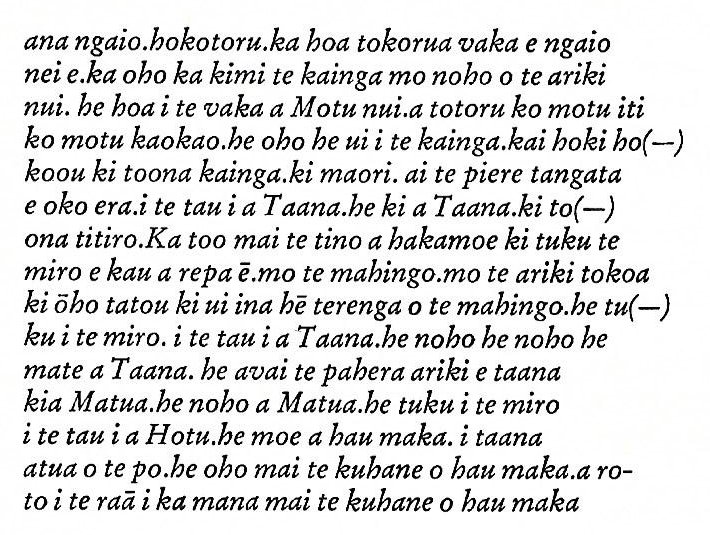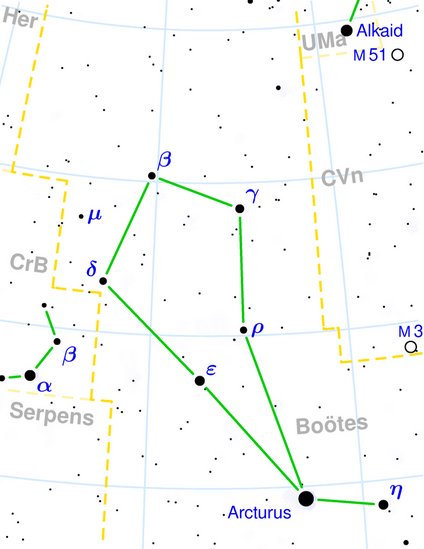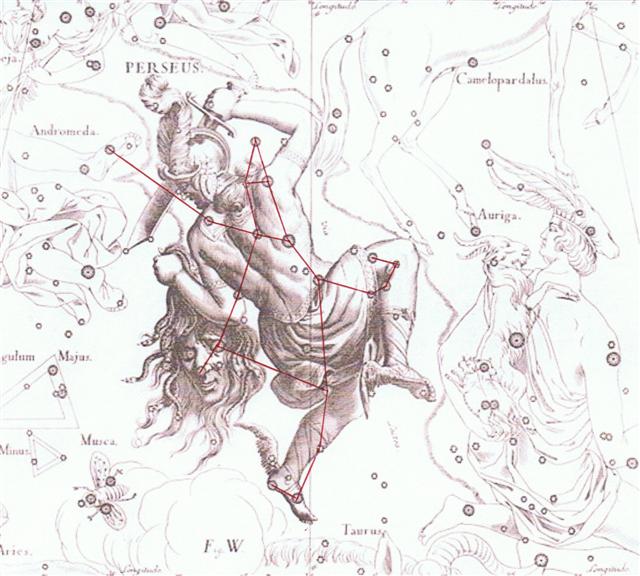The Eighth Land has a photograph of page 5 in Manuscript E
which enables us to
see how well this 18-lines long page has been copied:
.jpg)


First we can notice a change in ortography from g to
ng, for instance from Ataraga to Ataranga:
|
E:5 |
|
Photocopy |
Barthel |
|
i te tau ia Ataraga.
hetuku te tagata
i te vaka |
i te tau i a
Ataranga.he
tuku te tangata i te
vaka |
|
hehoa
hepiki heoho
hehimi i te kaiga
monoho o |
he hoa he piki he oho he kimi i te kainga
mo noho o |
|
te tagata. i te tau
ia Taana.
heki a Taana. ki ta- |
te tangata.i
te tau i a Taana. he kī a Taana.ki ta- |
|
ana gaio. hoko, toru.
Kahoa
to korua vaka egaio
|
ana ngaio.hokotoru.ka
hoa tokorua vaka e ngaio |
|
nei é. Kaoho
kahimi te
ka iga
monoho o te ariki |
nei e.ka oho ka kimi te kainga
mo noho o te ariki |
|
nui. hehoa
ite vaka a Motunui.
atotoru
Komotu iti |
nui. he hoa i te vaka a Motu nui.a
totoru ko motu iti |
|
Komotu
kaokao. heoho
heui i te Kaiga. kai hoki
ho |
ko motu kaokao.he oho he ui i te kainga.kai
hoki ho(-) |
|
ko oů nKito ona
kaiga. kimŕ ňri, ai te
piere tagata |
koou ki tona kainga.ki
maori. ai te piere tangata |
|
eoko era.
ite tau i a Taana.
heki
Ataaua. Kito |
e oko era.i te tau i a Taana.he ki a
Taana.ki to(-) |
|
ona titiro.
katoo mai tetiuo
kahaka moe
kituku te |
ona titiro.Ka too mai te tino a
hakamoe ki tuku te |
|
miro e kau are
pač. mo te mahigo. mo te ariki tokoa |
miro e kau a repa ē.mo te mahingo.mo
te ariki tokoa |
|
kiǒ ho.
tatou kiui ina hč terega
ote mahigaó.
hetu |
ki ōho tatou ki ui ina hē terenga
o te mahingo.he tu(-) |
|
ku i te miro. ite tau
ia Taana.
henoho
henoho
he- |
ku i te miro. i te tau i a Taana.he
noho he noho he |
|
mate a
Taana. hea vai tepa hera ariki.
e.taana |
mate a Taana. he avai i te pahera
ariki e taana |
|
kia Matua. hemoho a Matua, hetuku ite
miro |
kia Matua.he noho a Matua.he tuku i te
miro |
|
i te tau ia Hotu.
hemoe a
haumaka.
ita ana- |
i te tau i a Hotu.he moe a hau maka.i
taana |
|
atua o te po.
heoho mai te kuhane o
haumaka. a ro- |
atua o te po.he oho mai te kuhane o
hau maka.a ro- |
|
to i te raŕ i ka mana mai te kuhane o
haumaka |
to i te raā i ka mana mai te kuhane o
hau maka |
Although this in a way improved the spelling of the phoneme, I
would prefer not to change the original, which agrees for
instance with how
Bishop Jaussen wrote the words of Metoro.
|
SPELLING
The conventions of ortography on different
Polynesian islands are not the same and only
partially due to different pronounciations. In the
table below (from Krupa) is summarized some of these
features. Though deviations are not unusual. |
|
PPN |
p |
t |
k |
' |
f |
w |
s |
h |
m |
n |
ng |
l |
r |
|
PEP |
p |
t |
k |
' |
f, h |
w |
h |
fh |
m |
n |
ng |
l |
l |
|
MAO |
p |
t |
k |
fh |
f,
h, w |
w |
h |
fh |
m |
n |
ng |
r |
r |
|
TUA |
p |
t |
k |
fh |
f,
h, v |
v |
h |
fh |
m |
n |
ng |
r |
r |
|
MQS |
p |
t |
k, ' |
fh |
f,
h, v |
v |
h |
fh |
m |
n |
n, k |
', k |
', k |
|
TAH |
p |
t |
' |
fh |
f,
h, v |
v |
h |
fh |
m |
n |
' |
r |
r |
|
MVA |
p |
t |
k |
fh |
', v |
v |
' |
fh |
m |
n |
ng |
r |
r |
|
RAR |
p |
t |
k |
fh |
', v |
v |
' |
fh |
m |
n |
ng |
r |
r |
|
HAW |
p |
k |
' |
fh |
h, w |
w |
h |
fh |
m |
n |
n |
l |
l |
|
EAS |
p |
t |
k |
',
fh |
h, v |
v |
h |
fh |
m |
n |
ng |
r |
r |
|
PPN
= Proto-Polynesian,
PEP
= Proto-East-Polynesian and after that we
find Maori (New Zealand), Tuamotus,
Marquesas, Tahiti, Mangareva, Rarotonga,
Hawaii and Easter Island.
The sign
fh
stands for a
kind of 'f' formed with both lips and
'
stands for a glottal stop. The variations
r
/
l
are due to the fact that they represent only
one phoneme. Like the Chinese the ear of a
Polynesian cannot distinguish between these
two sounds. |
Then there are also different ways to separate the words in the
sentences: hetuku (photograph) divided into
he tuku (Barthel). I have noted hetuku, hehoa,
etc with red colour.
The same kind of phenomenon occurs also in other instances, e.g.
Motunui (photo) changed into Motu nui.
These places I have marked with blue.
An analytic mind has evidently dissolved the original whole
perceptions.

Finally there are a few instances which possibly might have changed
the meaning of the text and here I have used magenta.
The photo of page 5 was made in 1956:
"The first non-islander to learn of the existnence of Ms. E
seems to have been the late Chilean teacher Baeza, who came
across it in 1954 or 1955. After hearing from him, a group of
scientists from the Centro de Estudios Antropológicos of the
State University of Chile went to Hangaroa early in 1956 and had
a Bolivian student named Bejarano photograph the manuscript.
In April 1957, Don Gustavo Peńa gave me an (incomplete) set of
photographs in Santiago de Chile, so that I could examine them
...When I compared the original manuscript with the photographs
from 1956, I realized that several changes had been made ..." (The
Eighth Land, pp. 287-288.)
One of the changes was eliminating the name Pua Ara Hoa - which in a sense
ought to have been necessary if changes were made:
"Pua Ara Hoa was the central figure among the korohua, a
group of old Easter Islanders, who during the second decade of
this century were the last living eyewitnesses of the
pre-missionary era and who spent their time discussing among
themselves the indigenous traditions, which had fallen into
disregard among the younger Easter Islanders." (Ibid. p. 288)
Here - due to a force of synchronism (harmony between numbers
and time) - we should consider day 288 (October 15):
... The Julian calendar day
Thursday, 4 October 1582 was followed by the first
day of the Gregorian calendar, Friday, 15 October
1582 (the cycle of weekdays was not affected)
...
288 = 12 * 24 = 6 * 48 = 3 * 96. Finally 4 *
96 = 384 = 13 * 29˝ + ˝.
| te
henua |
te
honu kau |
manu
kake rua |
te
henua |
te
honu |
te
rima |
|
Kau. 1.
To move one's feet (walking or
swimming); ana oho koe, ana kau i te
va'e, ka rava a me'e mo kai, if you
go and move your feet, you'll get
something to eat; kakau (or also
kaukau), move yourself swimming.
2. To spread (of plants): ku-kau-áte
kumara, the sweet potatoes have
spread, have grown a lot. 3. To swarm,
to mill around (of people): ku-kau-á
te gagata i mu'a i tou hare, there's
a crowd of people milling about in front
of your house. 4. To flood (of water
after the rain): ku-kau-á te vai
haho, the water has flooded out (of
a container such as a taheta). 5.
To increase, to multiply: ku-kau-á te
moa, the chickens have multiplied.
6. Wide, large: Rano Kau, 'Wide
Crater' (name of the volcano in the
southwest corner of the island). 7.
Expression of admiration: kau-ké-ké!
how big! hare kau-kéké! what
a big house! tagata hakari kau-kéké!
what a stout man! Vanaga. To bathe,
to swim; hakakau, to make to
swim. P Pau., Mgv., Mq.: kau, to
swim. Ta.: áu, id. Kauhaga,
swimming. Churchill.
The stem kau does not appear
independently in any language of
Polynesian proper. For tree and for
timber we have the composite
lakau in various stages of
transformation. But kau will also
be found as an
initial component of various tree names.
It is in Viti that we first find it in
free existence. In Melanesia this form
is rare. It occurs as kau in
Efaté, Sesake, Epi, Nguna, and perhaps
may be preserved in Aneityum; as gau
in Marina; as au in Motu and
somewhere in the Solomon islands. The
triplicity of the Efaté forms [kasu,
kas, kau] suggests a
possible transition. Kasu and
kas are easy to be correlated,
kasu and kau less easy. They
might be linked by the assumption of a
parent form kahu, from which each
might derive. This would appear in
modern Samoan as kau; but I have
found it the rule that even the mildest
aspirate in Proto-Samoan becoming
extinct in modern Samoan is yet retained
as aspiration in Nuclear Polynesia and
as th in Viti, none of which
mutations is found on this record.
Churchill 2
Kaukau. 1.
Horizontal poles of a frame (of a
hare paega, or a paina
statue): he-hakatu'u te tama o te
paina, he-kaukau, they erect the
vertical poles of the paina then
they lay upon them the horizontal ones.
2. Group of people: e-tahi tuitui
reipá i Te Pei, ekó rava'a e-varu kaukau;
i-garo ai i Hiva, i te kaiga, a
necklace of mother-of-pearl is on te
Pei, few will find it (lit: eight
groups of people); it has remained in
Hiva, in our homeland. 3. To go
through, to pass through in unison;
he-hogi-mai te űka i te e'eo o te pua
kaukau-á i roto ite hare, the girl
smelt the fragrance of the pua
wafting inside the house. 4. Newborn
baby's first hand and feet movements (kaukau
or kau). The five
stages of a baby's development are:
kaukau, puepe, tahuri, totoro, mahaga.
Puepue = said of a newborn baby
when, a few weeks old, it begins to
distinguish people and objects:
ku-puepue-á te poki. Tahuri =
of a new-born baby, to move from side to
side: ku-tahuri-á te poki.
Totoro = to crawl; ki totoro te
poki, when the baby crawls.
Mahaga = baby when able to stand by
itself. Vanaga.

 |
 |
 |
 |
 |
 |
 |
|
*Ca14-24 |
*Ca14-25 |
*Ca14-26 |
*Ca14-27 |
*Ca14-28 |
*Ca14-29 (392) |
|
CLOSE TO THE FULL MOON: |
|
11 (159 +
308 - 366) |
April 12 (286 - 184) |
13 (468 = 365 + 103) |
14 (104 =
84 + 20) |
15 |
16 (392 - 366 + 80) |
|
δ Phoenicis (21.5) |
υ Andromedae (22.9) |
ACHERNAR
(End of the River) = α Eridani
(23.3), χ Andromedae (23.6), τ
Andromedae (23.9) |
ALSEIPH
(Scimitar) = φ Persei
(24.5), τ Ceti (24.7) |
no star listed (25) |
ANA-NIA-10 (Pillar-to-fish by)
χ
Ceti (26.1),
POLARIS
= α Ursae Minoris, BATEN KAITOS (Belly
of the Fish) = ζ Ceti
(26.6),
METALLAH = α Trianguli
(26.9) |

...
You are the one who shall stay here. We,
on the other hand, have to turn around.
Makoi replied, All right with me!
Then Ira continued to speak to
Makoi: Tomorrow, when it grows
light, set out and name the places
beginning with Apina. Makoi
replied, How shall I give the names?
Again Ira spoke, In Hiva
are the names that are to be taken to
name (the places of the new land). It
grew light and Makoi got up. He
set out and came to Apina. When
he arrived there, he gave the name
This is Apina Iti, this is Rapa Kura.
He went on and came to Hanga O Ua.
He gave the name This is Hanga O Ua
of the Beautiful Wave (vave renga).
Makoi went on, giving names,
until he had made a (complete) circle
around both sides (of the island). In
Apina Nui a stone (maea) was
erected, saying that the naming was done
on a (round) trip during a single day
...
 |
|
CLOSE TO THE SUN: |
|
12 (285 = 365 - 80) |
Oct 13 |
14 |
15 (288
= 96 + 192) |
16 |
17 (392 + 80 - 182) |
|
...
The canoes of Ava Rei Pua and of
Hotu were seen near the
(off-shore) islets. On the
fifteenth day
of the month of October (tangaroa
uri) the canoe of Hotu and
the canoe of Ava Rei Pua landed.
On the fifteenth day of the month of
October (tangaroa uri),
Nonoma left the house during the
night to urinate outside. At this point
Ira called out to Nonoma,
'Look at the canoe!' Nonoma ran,
he quickly went to Te Hikinga Heru
(a ravine in the side of the crater
Rano Kau) and looked around. There
he saw the double canoe way out near the
(offshore) islets, and the two (hulls of
the canoe) were lashed together. He ran
and returned to the front of the house.
He arrived and called into the house:
'Hey you! This canoe has arrived during
the night without our noticing it!'
Ira asked Nonoma, 'Where is
the canoe, which you say is lying out
there (in the water)?' Nonoma's
voice came back: 'It is out there (in
the water) close to the (offshore)
islets! There it lies, and the two
(hulls) are lashed together.' The four
of them (corrected for 'the six of
them') went out and picked up leaves (on
branches) to give signals. They picked
them up, went and arrived at Te
Hikinga and saw the canoe.
Raparenga got up, picked up the
leaves, took them in his hands, and
waved, waved, waved, waved ... (E:75) |
|
HEZE =
ζ
Virginis
(205.0),
Southern Pinwheel Galaxy = M83 Hydrae
(205.7) |
ε Centauri (206.3), κ Oct. (206.4)
*165.0 = *206.4 - *41.4 |
no star listed (207) |
τ
Bootis (208.2),
BENETNASH
(Leader of the Daughters
of the Bier) = η
Ursae Majoris
(208.5),
ν
Centauri (208.7),
μ
Centauri,
υ
Bootis (208.8) |
no star listed (209) |
MUPHRID
(Solitary Star) = η Bootis
(210.1), ζ Centauri (210.3) |
... Metallah was close to the pair Polaris and Baten
Kaitos and when this triplet (together with
χ Ceti) was
close to the current right ascension line at the
Full Moon then the present position of the Sun
should be in day 106 + 184 = 290, viz. at Muphrid
(the Solitary Star).

Or one could go in the opposite direction, e.g. from
October 15 (288) at Benetnash to right ascension
line *208 - *184 = *104 at the Scimitar (stretching
all the way to the right foot of Andromeda):

|
.jpg)











